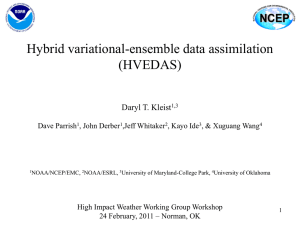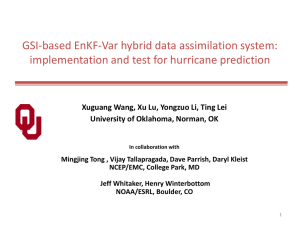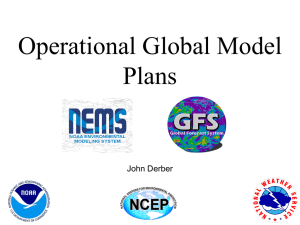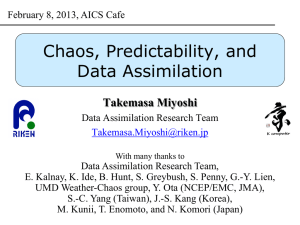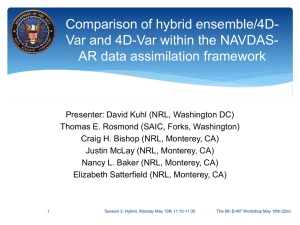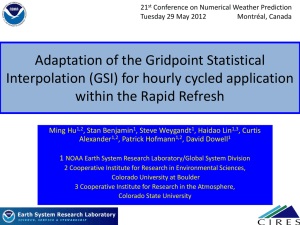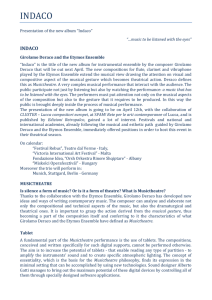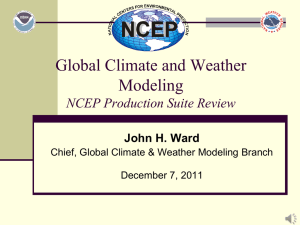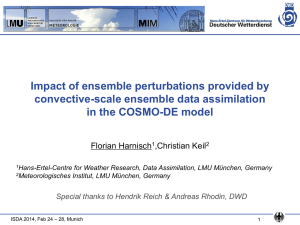Ensemble 4DVAR for the NCEP hybrid GSI
advertisement
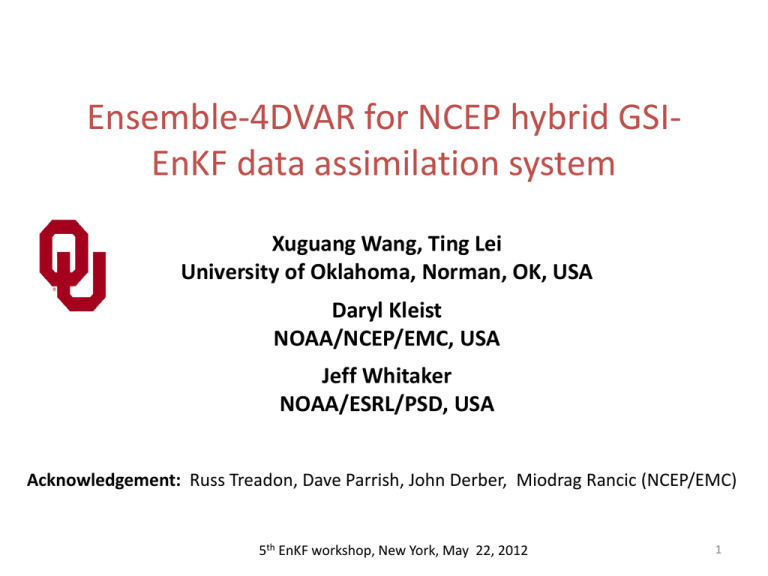
Ensemble-4DVAR for NCEP hybrid GSIEnKF data assimilation system Xuguang Wang, Ting Lei University of Oklahoma, Norman, OK, USA Daryl Kleist NOAA/NCEP/EMC, USA Jeff Whitaker NOAA/ESRL/PSD, USA Acknowledgement: Russ Treadon, Dave Parrish, John Derber, Miodrag Rancic (NCEP/EMC) 5th EnKF workshop, New York, May 22, 2012 1 Hybrid GSI-EnKF DA system Wang et al. 2012a EnKF EnKF analysis 2 member 2 forecast member k forecast control forecast Ensemble covariance GSI-ECV data assimilation EnKF analysis k control analysis Re-center EnKF analysis ensemble to control analysis EnKF analysis 1 member 1 forecast member 1 analysis member 1 forecast member 2 analysis member 2 forecast member k analysis member k forecast control forecast First guess forecast 2 Why Hybrid? “Best of both worlds” VAR (3D, 4D) EnKF hybrid References (examples) x x Hamill and Snyder 2000; Lorenc 2003, Wang et al. 2007ab,2008ab, 2009; Zhang et al. 2009; Buehner et al. 2010ab; Wang 2011; Robust for small ensemble x Wang et al. 2007b, 2009b; Buehner et al. 2010b Better localization for integrated measure, e.g. satellite radiance; radar with attenuation x Campbell et al. 2010 Benefit from use of flow dependent ensemble covariance instead of static B Easiness to add various constraints x x Outer loops , nonlinearity treatment x x More use of various existing capability in VAR x x Summarized in Wang 2010, MWR 3 NCEP pre-implementation test of ens3dvar hybrid http://www.emc.ncep.noaa.gov/gmb/wd20rt/experiments/prd12q3s/vsdb/ 4 ens4dvar for GSI: motivation • • • In ens3dvar, temporal evolution of error covariance not considered • • Conveniently avoid TL/ADJ of the forecast model. • Cheaper compared to TL/ADJ 4DVAR being developed for GSI (Rancic et al. 2012). Observations (e.g., satellite) are spreading through the DA window. Ensemble-4DVAR (ens4dvar) is further developed. It is a natural extension of ens3dvar. Temporal evolution of the error covariance within the assimilation window is realized through the use of ensemble perturbations (e.g., Buehner et al. 2010). Wang et al. 2012b 5 ens4dvar for GSI: method • Extended control variable method in 3D GSI hybrid (Wang 2010, MWR): J x , α 1 J1 2 J e J o ' 1 Add time dimension in ens4dvar 1 ' T 1 ' 1 T 1 1 o' ' T 1 x1 B x1 2 α C α y Hx R 1 y o ' Hx' 2 2 2 K x x α k x ek ' ' 1 k 1 Extra term associated with extended control variable Extra increment associated with ensemble B 3DVAR static covariance; R observation error covariance; K ensemble size; C correlation matrix for ensemble covariance localization; xek kth ensemble perturbation; x1' 3DVAR increment; x ' total (hybrid) increment; y o ' innovation vector; H linearized observation operator; 1 weighting coefficient for static covariance; 2 weighting coefficient for ensemble covariance; α extended control variable. Wang et al. 2012b 6 One obs. example for TC –3h increment propagated by model integration t=0 ens4dvar t=0 * -3h ens3dvar t=0 0 3h time 7 Another example Temp. t-3h t t+3h Height t-3h Downstream impact t t+3h Upstream impact 8 Experiment I Test period: Aug. 15 2010 – Sep. 20 2010 Model: GFS T190L64 Observations: all operational data Data assimilation configuration: o GSI (gsi) o ensemble 3DVAR (ens3dvar) o ensemble 4DVAR: 2-hourly frequency (ens4dvar) 1-hourly frequency (ens4dvar-hrly) o excluding the balance constraint: ens3dvar-nb ens4dvar-nb 9 Hurricane track forecasts 2010 hurricanes • ens3dvar better than GSI and further improvement by ens4dvar. • Balance constraint in GSI hurt TC forecast for both ens3dvar and ens4dvar. 10 Global forecasts verified against EC analyses Height Temperature • ens3dvar better than GSI and further improvement by ens4dvar. • Balance constraint in GSI help both ens3dvar and ens4dvar. 11 Global forecasts verified against conv. obs. 6h wind 6h temp Improvement of ens3dvar hybrid and ens4dvar hybrid over GSI ens4dvar showed further improvement over ens3dvar especially for wind 12 Global forecasts verified against conv. obs. 96h wind 96h temp Significant improvement of ens3dvar hybrid and ens4dvar hybrid over GSI ens4dvar showed further improvement over ens3dvar especially when “nb” balance constraint seems helpful at early lead time, but hurt at later lead time13for ens4dvar Experiment II Test period: July 15-Aug. 7, 2011 Model: GFS T126L64 vs. GFS T126/T62L64 Observations: all operational data Data assimilation configuration: o ensemble 3DVAR no static B dual resol. (ens3dvar-dual) o ensemble 4DVAR no static B dual resol. (ens4dvar-dual) o ensemble 3DVAR w. static B dual resol. (hyb-ens3dvar-dual) o ensemble 4DVAR w. static B dual resol. (hyb-ens4dvar-dual) o ensemble 3DVAR no static B single resol. (ens3dvar-sgl) o ensemble 4DVAR no static B single resol. (ens4dvar-sgl) Lei et al. 2012 14 Single vs. dual resolution 6h wind 6h temp Impact of static B at dual resolution 6h wind 6h temp Summary and ongoing work ens4dvar capabilities were developed for GSI. Tests show that ens4dvar further improved upon ens3dvar. Further diagnosing the difference between dual and single resolution, w/o static covariance, impact of balance constraint. Various capabilities associated with ens4dvar are in development and test: e.g. temporal localization, digital filter weak constraint, sophisticated weighting of static vs. ensemble covariance 17 References Campbell, W. F., C. H. Bishop, D. Hodyss, 2010: Vertical Covariance Localization for Satellite Radiances in Ensemble Kalman Filters. Mon. Wea. Rev., 282-290. Lorenc, A. C. 2003: The potential of the ensemble Kalman filter for NWP – a comparison with 4D-VAR. Quart. J. Roy. Meteor. Soc., 129, 3183-3203. Buehner, M., 2005: Ensemble-derived stationary and flow-dependent background-error covariances: evaluation in a quasi-operational NWP setting. Quart. J. Roy. Meteor. Soc., 131, 1013-1043. Hamill, T. and C. Snyder, 2000: A Hybrid Ensemble Kalman Filter–3D Variational Analysis Scheme. Mon. Wea. Rev., 128, 2905-2915. Wang, X., C. Snyder, and T. M. Hamill, 2007a: On the theoretical equivalence of differently proposed ensemble/3D-Var hybrid analysis schemes. Mon. Wea. Rev., 135, 222-227. Wang, X., T. M. Hamill, J. S. Whitaker and C. H. Bishop, 2007b: A comparison of hybrid ensemble transform Kalman filter-OI and ensemble square-root filter analysis schemes. Mon. Wea. Rev., 135, 1055-1076. Wang, X., D. Barker, C. Snyder, T. M. Hamill, 2008a: A hybrid ETKF-3DVar data assimilation scheme for the WRF model. Part I: observing system simulation experiment. Mon. Wea. Rev., 136, 5116-5131. Wang, X., D. Barker, C. Snyder, T. M. Hamill, 2008b: A hybrid ETKF-3DVar data assimilation scheme for the WRF model. Part II: real observation experiments. Mon. Wea. Rev., 136, 5132-5147. Wang, X., T. M. Hamill, J. S. Whitaker, C. H. Bishop, 2009: A comparison of the hybrid and EnSRF analysis schemes in the presence of model error due to unresolved scales. Mon. Wea. Rev., 137, 3219-3232. Wang, X., 2010: Incorporating ensemble covariance in the Gridpoint Statistical Interpolation (GSI) variational minimization: a mathematical framework. Mon. Wea. Rev., 138,2990-2995. Wang, X. 2011: Application of the WRF hybrid ETKF-3DVAR data assimilation system for hurricane track forecasts. Wea. Forecasting, 26, 868-884. Li, Y, X. Wang and M. Xue, 2011: Radar data assimilation using a hybrid ensemble-variational analysis method for the prediction of hurricane IKE 2008. Mon. Wea. Rev., in press. Buehner, M, P. L. Houtekamer, C. Charette, H. L. Mitchell, B. He, 2010: Intercomparison of Variational Data Assimilation and the Ensemble Kalman Filter for Global Deterministic NWP. Part I: Description and Single-Observation Experiments. Mon. Wea. Rev., 138,1550-1566. Buehner, M, P. L. Houtekamer, C. Charette, H. L. Mitchell, B. He, 2010: Intercomparison of Variational Data Assimilation and the Ensemble Kalman Filter for Global Deterministic NWP. Part II: One-Month Experiments with Real Observations. Mon. Wea. Rev., 138,1550-1566. Wang, X., D. Parrish, D. Kleist, and J. Whitaker, 2012a: GSI-based hybrid ensemble-variational data assimilation system for NCEP Global Forecast System: reduced resolution experiments. Mon. Wea. Rev. , in review. 18 Hybrid DA posters Govindan Kutty (next talk) Assess the impact of observations in NCEP GSI-EnKF hybrid data assimilation system through OSE and ensemble based observation impact estimate global global 200hPa 200hPa 250hPa 300hPa estimate actual 250hPa 300hPa 500hPa 500hPa 700hPa 700hPa 850hPa 850hPa 925hPa 925hPa 1000hPa 1000hPa -0.0035 -0.0030 -0.0025 -0.0020 -0.0015 -0.0010 -0.0005 0.0000 2 error reduction / gridpoint (K ) estimate actual -0.008 -0.006 -0.004 -0.002 -1 2 error reduction /grid point (ms ) 0.000 19 Hybrid DA posters Ting Lei (poster) GSI based Ensemble-4DVar for NCEP GFS at Single and dual resolutions GSI based Ensemble-4DVar for NCEP GFS at Single and Dual resolutions GSI based Ensemble-4DVar for NCEP GFS at Single and dual resolutions based Ensemble-4DVar for NCEP GFS at Single and dual resolutions 20 Hybrid DA posters Andrew Mackenzie (poster) Impact of observations on tropical cyclone forecasts using the GSI-EnKF hybrid data assimilation system 21 Hybrid DA posters Yongzuo Li (poster) GSI based Ensemble-4DVar for NCEP GFS at Single and dual resolutions Assimilation of Radar Data with the hybrid data assimilation for high resolution hurricane predictions GSI based Ensemble-4DVar for NCEP GFS at Single and dual resolutions based Ensemble-4DVar for NCEP GFS at Single and dual resolutions 22 An example from GSI hybrid GSI (static covariance) Hybrid (ensemble covariance) K k k Wang et al. 2012a 23
